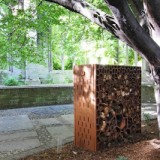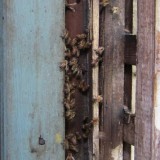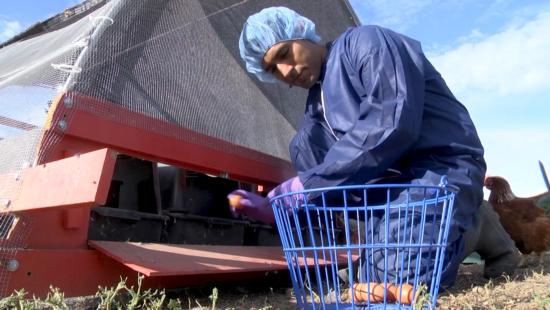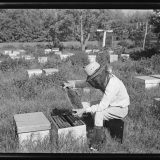
Of all the subjects we cover on this blog none is as controversial as beekeeping. I think most outsiders would be surprised as just how testy things get when conventional and natural beekeepers bump into each other. It’s a debate every bit as heated as gun control or abortion.
The two sides are divided on a number of practices. Probably the most important is the issue of whether or not to treat bees for diseases and pests (most notably, varroa mites). Other issues include the use of foundation, keeping feral bees, re-queening and the type of bee housing. Even within each camp there’s a kind of spectrum between a hyper-interventionist stance and a hands-off approach. Some “natural” beekeepers treat their bees with essetial oils, for instance.
But I think the divide is more philosophical. It’s about systems thinking versus an overly reductionist stance. Reductionsim and systems thinking, in fact, can be complimentary. In science you take apart a problem to look at individual causes and effects. But you must, at some point, put those parts together to look at the whole. As the alchemical saying goes, “solve et coagula,” “dissolve and join together.” Reductionism is fine and useful. What’s not good is the arrogance that comes from thinking that since you understand part of the problem you understand the whole and can immediately start applying technological solutions. As Nassim Taleb has pointed out in his books The Black Swan and Anti-fragile: Things That Gain from Disorder, monkeying with complex systems from a point of ignorance leads to horrible, unintended consequences.
Take the issue of varroa mite treatments. Let’s say you test a miticide’s toxicity on bees. You expose the bees to the miticide. The mites die and the bees live. Success! But . . . the unforeseen. What if that treatment wreaks havoc on the microbiology of the hive? What about a chemical’s effect on the symbiotic relationships with those microorganisms and their bee hosts? What happens when the mites develop resistance to the miticide? What happens when propped-up weak bees swarm and establish themselves in the midst of a feral population? These are all difficult to understand long term questions that highlight the danger of moving quickly from an isolated study into an immediate application. Natural beekeeper Michael Bush has written and lectured extensively on these issues.
Natural and conventional beekeepers are also asking different questions. I’ll be frank. The California State Beekeeper’s Association meeting that I attended in 2015 left a very bad taste in my mouth. It really should have been called the Almond Pollinator’s Association meeting. It was all about facilitating the pollination of California’s unsustainable 1 million acres of almonds. Those million acres are pollinated by at least 1.7 million beehives that have to be trucked out of state every year once the almond pollination season is over. Speaker after speaker blamed natural beekeepers for their disease problems. Retired UC Davis bee expert Eric Mussen brought the ad hominem attacks to a fevered pitch by calling natural beekeepers, “hippies” and “bee-havers.” I haven’t heard “hippie” used this way since Spiro Agnew left this mortal coil. And Agnew would have been right at home with an organization that still has a ladies auxiliary in 2016 (in contrast to natural beekeeping organizations I’ve seen that are integrated and, in fact, made up of a solid majority of women).
The question of how we pollinate millions of acres of monocultured crops in different parts of the country is a different question than how to keep a few hives in a biodiverse urban area. To be fair, the first question is essential since it’s how we currently keep everyone fed. But much of the advice given to large scale beekeepers does not always apply to small scale backyard beekeepers.
The hubris can go both ways. Those of us on the natural beekeeping side can also think we understand the whole better than we do. We can fall into the same reductionist traps. Just because a mite treatment is “natural,” such as dousing a hive in essential oils, does not mean that it’s healthy for the bees. We also must not lose sight of the fact that we are in a relationship with honeybees that goes back many thousands of years. They aren’t exactly wild animals in most places and may depend, to varying degrees, on our support. Someday we might reach a kind of sweet spot between highly interventionist and low intervention beekeeping methods. My bet is that it’s on the low intervention side of the equation, but only time will tell.
What do you think? Leave a comment.





What do I think? I think that mankind has always liked to play god and control everything and that he has done a lot of damage doing so!
Great topic. I caught some bees with a trap and 3 years later still have
my hive. I make sure they have plenty of space, water source and have a bee friendly yard but that’s about it. I observe them. They are always bringing pollen in. It would highly annoy some people but it works. I am going to read and learn more but works for me. I love my bees and they are very happy. I can’t understand why we would think we know better than the bees.
i second that thought of why do we think we know more than the bees. i have been keeping bees in my urban yard for three years as well. the first year i moved the top bars frames around before winter close up and the bees starved. so now i leave them alone, they have made it through two winters since then. i live in alberta where we get colder temperatures.
The best argument I have heard against using “natural” pesticides in my backyard is that whatever is good at killing the “bad” bugs, is probably also good at killing the “good” bugs. This seems like an obvious point that gets overlooked when it comes to managing insects, fungi, bacteria, etc…in any ecosystem.
Most problems are not solving using a reductionist theory since processes mostly affect each other.
Max, I do use what I call “natural” pesticides. However, my whole yard is not sprayed. I use garlic, onion, hot pepper, cooking oil and Dawn blended and diluted to spray on food plants. However, the whole yard or area not directly under the plant is not sprayed. My argument for this is there is no harmful residue to wash into the water supply or be spread over the yard by wind and rain.
Maybe I am wrong with this justification, and will entertain ideas of why I am wrong. When people tell me something is okay because it is “natural,” I reply, “So is arsenic.”
If I am ever able to get bees, I hope I will learned lots from this site. At least, I will know where to get answers.
Over time, I’ve found that the less I screw with my bees, the better they seem to do. Diseases and parasitic mites are here to stay. There’s no getting rid of them, no matter how many treatments you do, “natural” or not. Every time you treat with anything, be it a synthetic pesticide or a strong “natural” essential oil, you are weakening the bees themselves, perhaps directly, perhaps by throwing off the microbiome of the hive, probably both, plus you are directly breeding for stronger, treatment resistant mites and diseases.
My current strategy is to allow the bees to breed and adapt. This includes collecting local swarms, as well as allowing my bees to raise local queens. It’s hard to do this with one or two hives, since there’s a good chance all your bees will die over winter. Ten hives is better, which is about what I’m at, 100 would be even better. Not everybody can keep 100 or ten or even five hives, so maybe people can form beekeeping “collectives,” in which each member has one to three hives, and every spring, the members with colonies that survived make splits to replenish the colonies that perished. This way we can maintain a sustainable beekeeping practice, without resorting to regularly importing bees and queens which have been continuously treated, and are completely un-adapted to the local area.
Great article and conversation. I suspect that Adam has brought up a point that I have made about chickens, and other prolific animals. Nature never intended for them all to survive, and if we left them to their own devices, high mortality might be the norm, and better for the overall population by only allowing the fittest ten percent to carry over to the next season. If we could allow this to take place naturally, with his suggestion of 100 hives per keeper as an example, the next season might start us off with one or two strong hives to build upon. The commercial model that requires millions of hives right at the start of spring would seem to be the problem, since it forces commercial beekeepers to value each individual bee equally whether it is truly fit or not. It reminds me of hatchery chicks, where quantity is valued over quality, and many resulting adult hens are “defective” healthwise in some way.
Natural beekeeping with minimal intervention seems to me to be the sensible path forward. But I know that economic forces will make this a hard path to follow when, as Eric points out, we are all fed by this large-scale agricultural model.
Backwards backyard beekeeping will at least provide nurseries for some less-interfered-with bees, and I hope those will continue to provide support for the larger populations.
I just re-read my post and realized how dim it sounds. Of course the high mortality rates we are seeing are not as nature intended or we’d be worse off than we are right now. Posting without coffee should be avoided at all costs.
When I read your headline, I thought the debate would be about whether hobbyists should be keeping honeybees, given their impact on native pollinators. I just read about this recently, from a Norwegian study:
http://sciencenordic.com/wild-bees-lose-fight-flowers
It makes sense to me, considering that one beehive visits about 225,000 flowers per day and also has supplemental feed when flowers are scarce, but it’s the first I’ve heard of it. Has anyone else heard of this or seen other information?
Hi Bonnie. Thanks for the link. I just now got a chance to read it, and it’s good. I worry about this, too, a little.
Admittedly I am not a biologist, but my opinion is that we can have both if we work with a mindset toward abundance rather than scarcity. We need more plants in our cities and suburbs, more variety of plants, more native plants. We need more spaces left open to provide habitat for the native pollinators–most of them don’t use constructed hives, but instead different sorts of burrows and nests in the soil and and in plant material.
I wonder if some of their woes are not more from us humans paving over the entire world than from their honeybee cousins. What if we all had yards full of plants for our insect friends instead of lawns and box hedges? What if little strips of uncultivated, undeveloped land was allowed to exist in between agricultural fields and around new housing developments? I think there is plenty to go around if we can learn to share.
Can you imagine the same vitriol blaming backyard gardeners for problems with conventional farms?
Some of the trolls in the forums post against treatment free beekeeping like it was their full time job to discredit it. I wonder if it is.
My backyard hives are like Vegas. What happens (or doesn’t happen) in my hives…
Interesting conversation, but I’m even more fascinated by the artwork! What’s going on with these wacky funsters? And what’s up with boyfriend’s, um, codpiece in upper left? What is the source and date, and is there a description of what’s depicted? Is that wagon wheel some sort of honey extractor? They obviously have quite an operation going on there…I particularly like the smirking hog in the lower right–he’s up to something.
With skeps, you don’t use an extractor. I think the wheel is used to pull up buckets of water from the well.
In theory, if you bang on metal, an approaching swarm will land immediately, allowing for a nice neat capture. I’m assuming that’s why they’re beating on the bowls. The fellow up the ladder is scraping the already-landed bees into an empty skep to increase the size of his apiary. As for the cod-piece, that’s outside of beekeeping and my knowledge base.